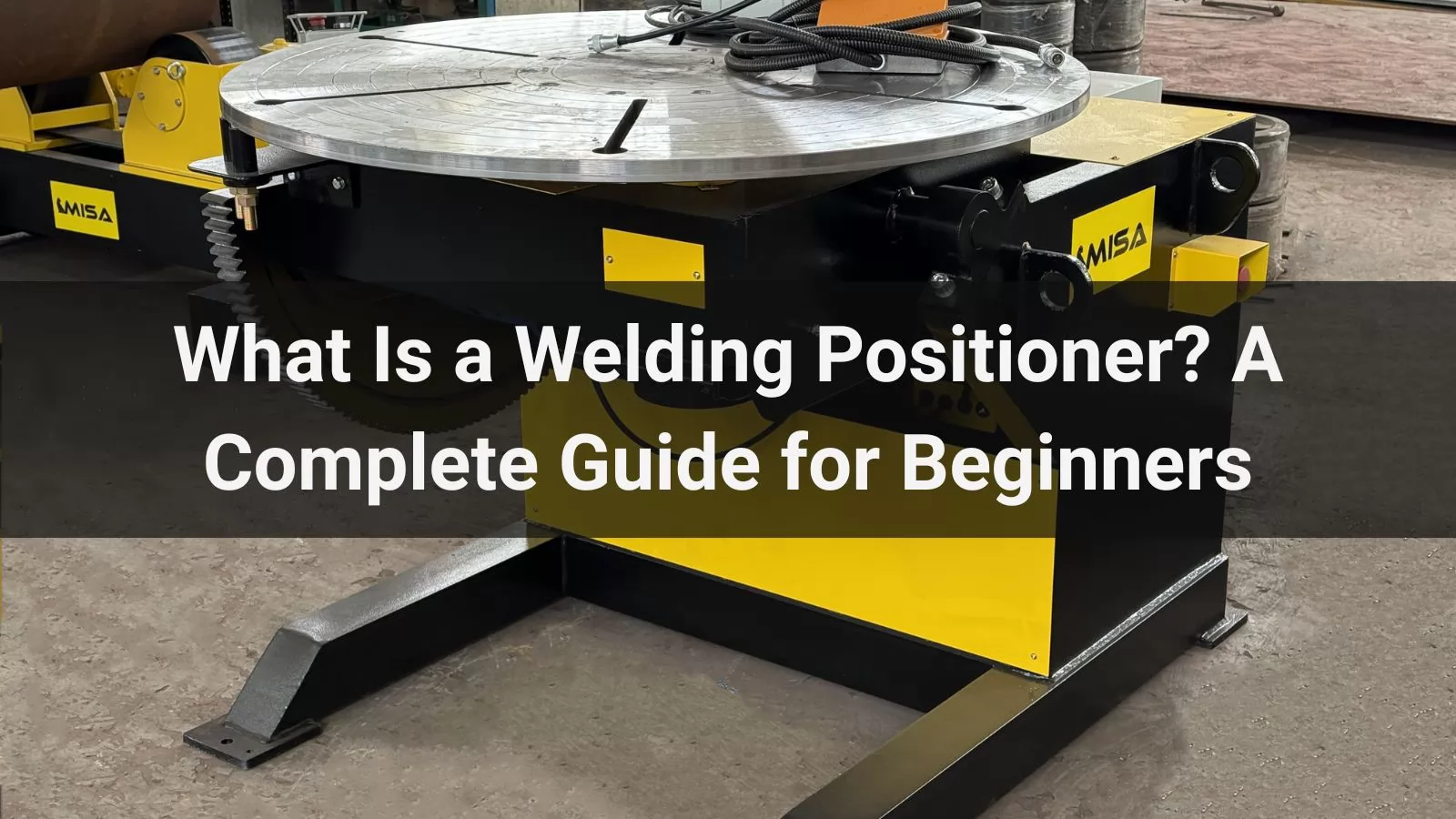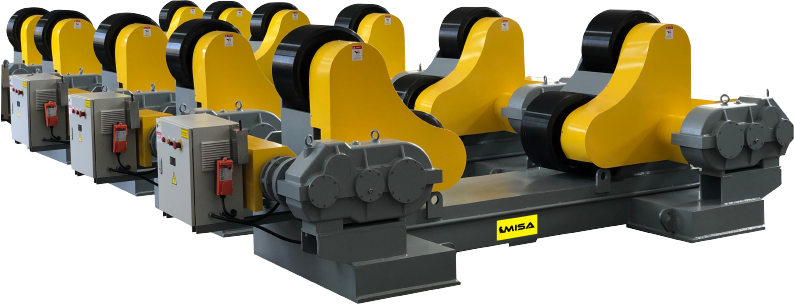


.png)
.png)
.png)



Welding is an essential part of modern manufacturing — from building massive ships to fabricating small metal components. Yet, if you’ve ever tried welding for the first time, you’ll quickly notice that one of the biggest challenges isn’t just about the heat or technique — it’s about positioning. Getting the right welding angle can determine whether your weld is smooth and strong or uneven and weak.
This is where a welding positioner comes in. Whether you’re an aspiring welder, a hobbyist, or part of a professional workshop, understanding how welding positioners work will help you weld smarter, safer, and with greater precision. In this guide, we’ll explore what a welding positioner is, how it works, and why companies like MISA are redefining how modern welding is done.
A welding positioner is a mechanical device designed to hold, rotate, and tilt a workpiece so you can weld it from the best possible angle. Instead of forcing the welder to adjust their position or posture, a positioner allows the workpiece to move, keeping the welding process flat and steady.
Imagine needing to weld a pipe or circular component from multiple sides. Without a positioner, you’d have to stop, reposition the part, and continue welding — a process that’s time-consuming and increases the risk of uneven seams. A welding positioner automates this movement, maintaining the perfect angle for consistent and high-quality welds.
For beginners, this tool eliminates much of the physical strain and guesswork in manual welding. For professionals, it boosts productivity, consistency, and safety in every project.
When you start learning welding, it’s natural to focus on controlling the arc, temperature, and filler metal. But soon you’ll realize that even if your technique is perfect, poor positioning can ruin your results. The way your workpiece is placed affects how the molten metal behaves — and gravity always wins.
For example:
That’s why welders prefer to keep their joints as flat as possible. But in real-world applications — like working on pipes, tanks, or machinery frames — it’s not always feasible to move the workpiece by hand. That’s where a welding positioner saves the day.
Instead of repositioning yourself around the job (which can be exhausting and unsafe), a welding positioner allows you to rotate the job itself. It turns complex or awkward angles into smooth, flat welds — even for beginners.
At its core, a welding positioner is simple: it’s a powered table that rotates and tilts to keep your workpiece in the most comfortable welding position. But inside the machine, several important components work together to make that happen.
| Component | Function |
|---|---|
| Rotating Table | Holds the workpiece and rotates it at a controlled speed for even weld coverage. |
| Tilt Mechanism | Allows the workpiece to be angled up to 90° or more, so you can always weld in the flat position. |
| Drive Motor | Provides consistent rotation — crucial for achieving uniform weld beads. |
| Foot Pedal or Remote Control | Lets you adjust rotation speed or direction without leaving your workstation. |
| Clamping System | Keeps the workpiece securely fixed on the table, preventing slips or vibrations. |
Using these components together, the positioner makes welding far more efficient. Instead of constantly stopping to move your part, you simply set the speed and angle — and focus entirely on making clean, strong welds.
In professional workshops, advanced positioners include motorized controls and programmable settings for repetitive or high-volume welding tasks. But even the simplest beginner-friendly models can make a huge difference in weld quality and comfort.
Welding positioners are available in a range of configurations, each engineered to accommodate different workpiece shapes, weights, and production requirements. Understanding the main types of welding positioners will help you select the most suitable equipment for your specific welding application.
| Type | Key Features | Typical Applications |
|---|---|---|
| Bench-Top Positioners | Compact and lightweight units designed for handling small to medium-sized workpieces. They provide steady rotation and are ideal for precision welding in workshops with limited space. | Suitable for small components, fittings, and precision mechanical parts. |
| Turntable Positioners | Equipped with a rotating table that securely holds the workpiece for smooth, consistent circular welding. Provides stable rotation and can be integrated into semi-automated systems for repetitive welds. | Commonly used for circular welds, flanges, tanks, and round components. |
| Tilting Positioners | Allow both rotation and controlled tilting, enabling the operator to position the workpiece at the ideal welding angle. This design improves weld access, accuracy, and operator comfort. | Used in general fabrication workshops and mid-size production lines. |
| Head and Tailstock Positioners | Support the workpiece at both ends, allowing it to rotate on a horizontal axis. This setup provides excellent stability for long or heavy parts that need to be welded continuously. | Ideal for shafts, beams, long pipes, and cylindrical structures. |
| Pipe Welding Positioners | Specifically designed to align and rotate pipes for circumferential welding. Often used together with welding rotators to handle large or heavy pipes efficiently. | Common in oil & gas, petrochemical, and pressure vessel manufacturing. |
Choosing the right welding positioner is about matching the machine’s capabilities with your specific production needs. The goal is to ensure safety, efficiency, and the highest weld quality while keeping operational costs under control. Below are the key factors to consider when selecting the ideal welding positioner for your workshop or production line.
In summary, the right welding positioner not only improves weld quality but also enhances operator comfort, reduces rework, and increases production efficiency. By carefully evaluating these factors, you can ensure the machine you select fits your workflow both technically and economically.

MISA has earned a strong reputation as a global manufacturer of high-quality welding and positioning automation equipment. With a focus on precision, innovation, and long-term reliability, MISA’s welding positioners are engineered to help fabricators achieve superior welds with less effort and greater consistency.
Every MISA welding positioner is built to deliver smooth, stable rotation and precise control. Whether you’re working with small components or large industrial assemblies, MISA positioners allow you to achieve the perfect welding angle with minimal manual adjustment. This results in cleaner welds, reduced downtime, and a safer working environment.
MISA designs its equipment with robust steel construction and high-quality drive systems to ensure long service life and dependable performance under heavy loads. Each unit is thoroughly tested to meet international standards for safety and quality.
MISA welding positioners are widely used across industries including oil & gas, construction, energy, and machinery manufacturing. Their adaptable design supports various welding processes—from manual and semi-automatic setups to fully robotic systems.
Beyond standard models, MISA provides custom-built solutions to meet specific production requirements. The company’s engineering team works closely with clients to tailor the positioner’s size, capacity, and control systems for unique applications. With reliable after-sales service and technical support, MISA ensures every customer receives maximum value from their investment.
| Key Advantages | Description |
|---|---|
| High Precision | Consistent rotational speed and accurate tilt control ensure high-quality, repeatable welds. |
| Strong Load Capacity | Engineered to handle a wide range of workpiece weights—from small parts to large cylindrical structures. |
| Customizable Design | Optional configurations for table size, control systems, and integration with welding manipulators or robots. |
| Global Service Network | Comprehensive technical support and maintenance service for clients worldwide. |
With its commitment to quality and customer satisfaction, MISA continues to set the standard in welding and positioning automation. Choosing MISA means investing in reliability, precision, and long-term performance.
Welding positioners are essential tools that help welders improve efficiency, precision, and safety. By allowing the workpiece to be rotated and tilted into the best welding position, these devices make it easier to produce consistent, high-quality welds—especially for heavy or complex structures. From bench-top models for small workshops to industrial-scale systems for manufacturing plants, there’s a positioner suited for every need.
For beginners, learning to use a welding positioner not only makes welding easier but also helps develop better technique and control. Instead of struggling with awkward positions or inconsistent welds, a positioner lets you focus on perfecting your weld quality and speed.
If you’re looking for reliable, well-engineered welding positioners, MISA offers a wide selection of models that combine durability, precision, and ease of use. Whether you’re a small fabrication shop or a large-scale production facility, MISA’s automation solutions can help streamline your welding operations and improve overall productivity.
For more information about MISA welding positioners or to request a customized solution, visit MISA’s product section above or contact their team of experts for professional guidance.
Work smarter, weld safer, and achieve better results—with MISA welding positioners by your side.


